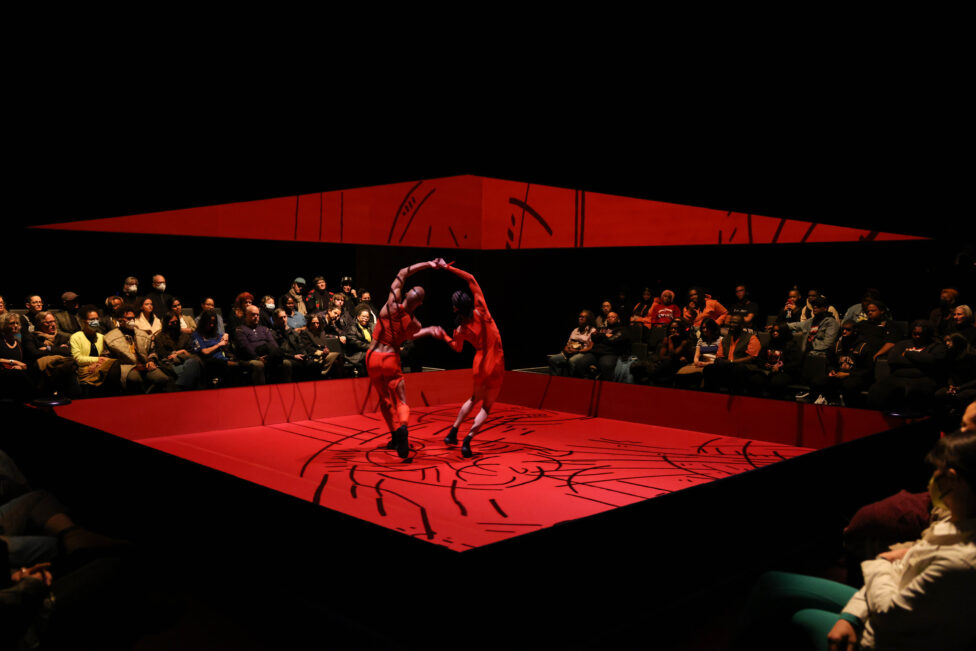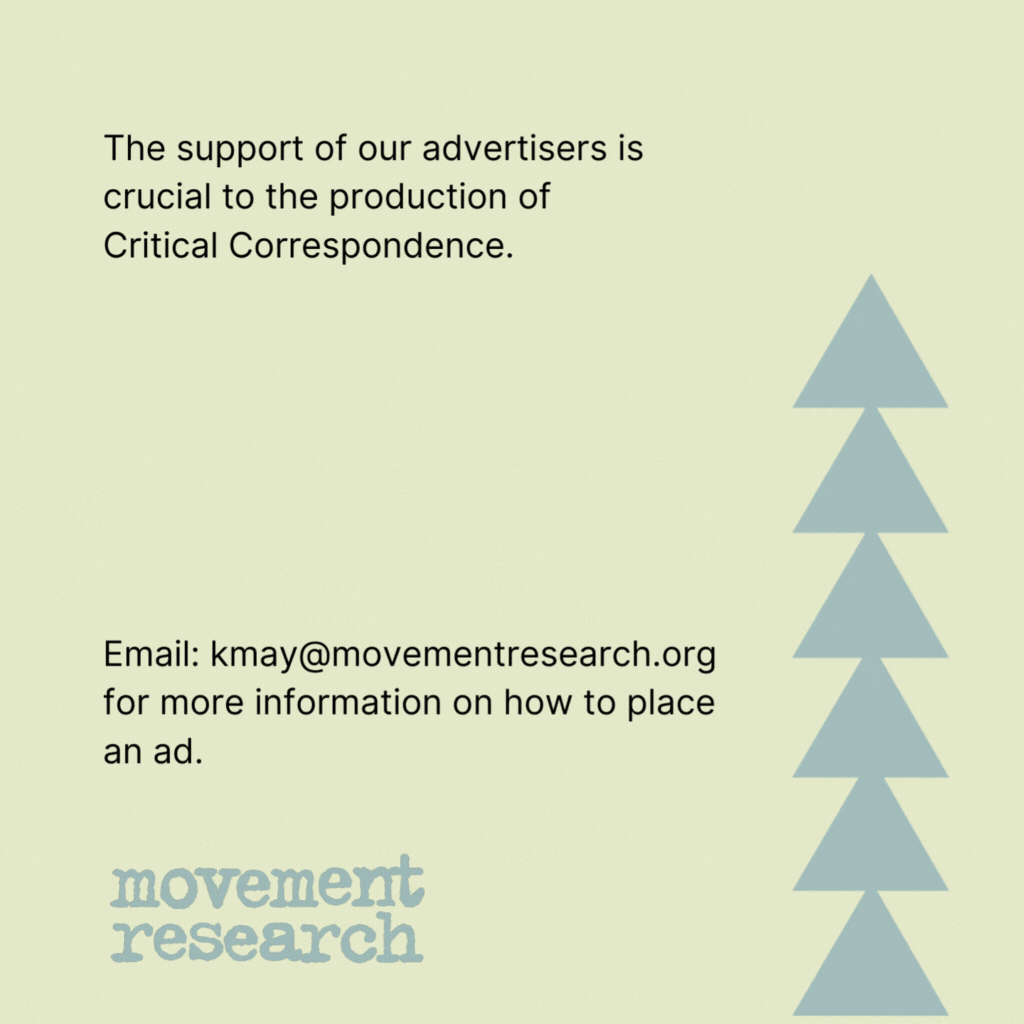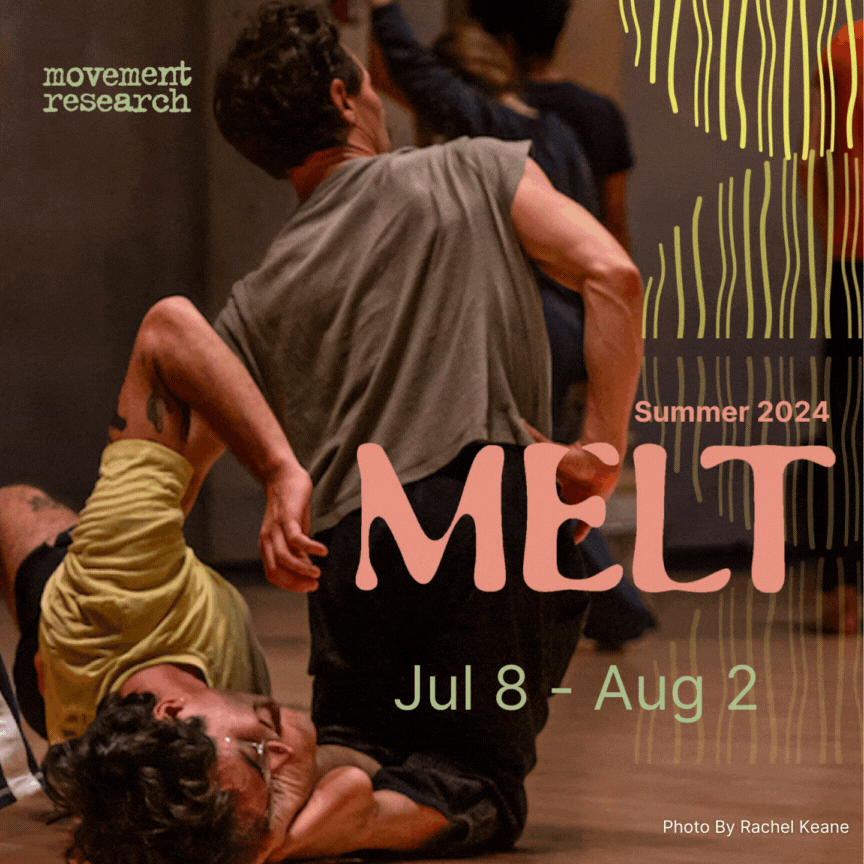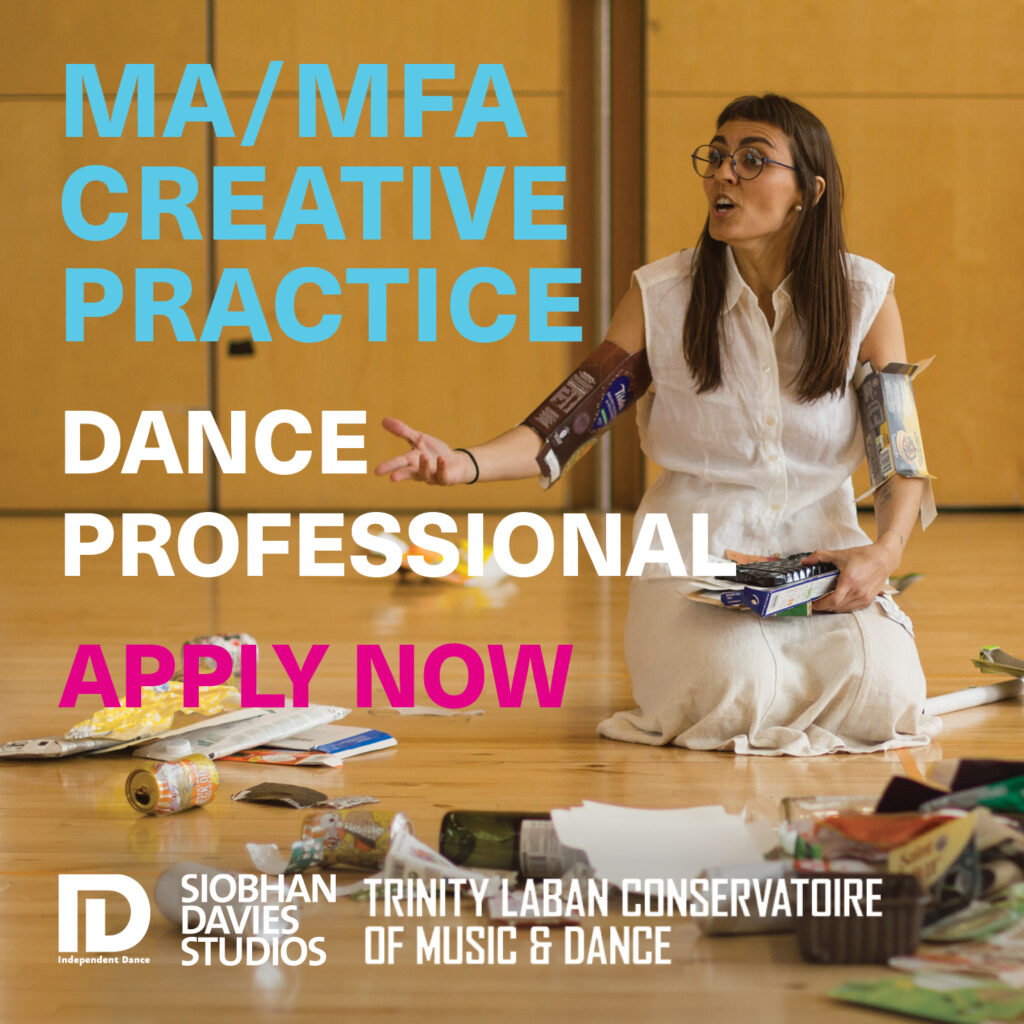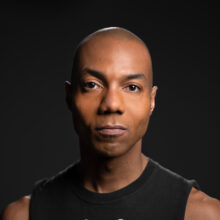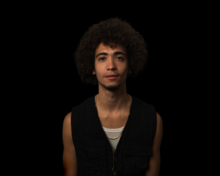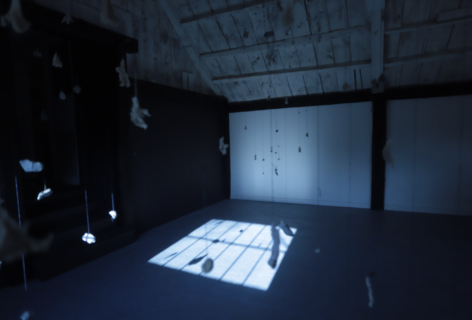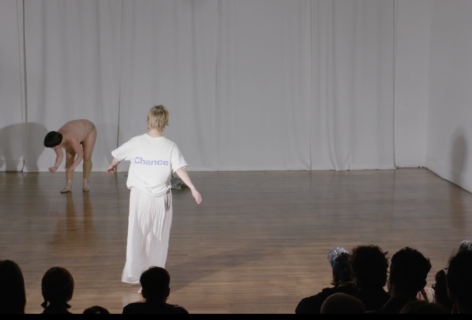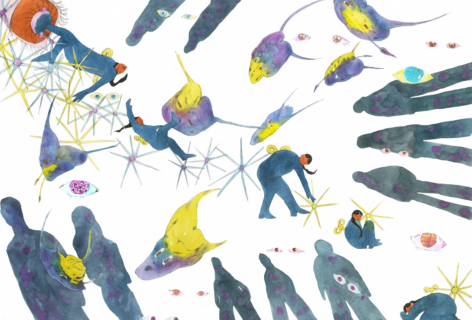Tushrik Fredericks and Shamel Pitts come together to have a conversation reflecting back on the way in which they felt while practicing and performing Pitts’ piece titled Touch of Red. They talk about being close, vulnerable, exposed and seen, as they allow themselves to be soft, embracing the idea of black men being soft.
– Nicole Soto Rodríguez, CC Co-editor
This article has been edited for the purpose of publication.
Shamel Pitts: So yesterday my therapist told me, “suchness” like why is it this way or why is it that way? Because it is, it just is. You can have/be different qualities, I can bring out the possibilities of wholeness or just being without breaking it into sections like sad or happy or connecting all emotions, the sense of all encompassing.
Tushrik Fredericks: The full totality of it
SP: With Touch of RED I was looking at, or trying to remember one of the artworks that also sparked my curiosity towards creating the content in Touch of RED. It had a lot to do with not only our own connection as dancers, but also with this sense of radical vulnerability between men, especially men of color. One thing that stimulated it was a piece by the artist Tatyana Fazlalizadeh, she is a muralist. I showed you this huge mural of her’s that’s close to my house here?
TF: Yeah, yeah. Where they defaced it.
SP: Yes, the man with watery soft eyes and a flower close to his face and along the image it has written “let black men be soft”. Because I live in a predominantly African American and black community, a lot of people from the neighborhood started to deface that artwork, that mural, but also started to write on it different texts. Like let black men be strong, and a black man is soft, then we will be preyed upon, and let black men be leaders of their communities. We need to be strong, we are caretakers, we’re protectors, we have that responsibility that I think informs a certain quality of being. And what Tatyana was saying as a response to them, with her proposition of using let Black men be soft, was really to say, let Black men be human, let black men be whole like, yes!, Let us just be.
TF: For sure. Yes!
SP: Encompassing all that is innate to come up to us. And, if we think about one of the things I sort of learned with touch of red is, that softness is actually a quality, it’s a form, it’s how the form becomes informed. Which means that you can be inside any movement, regardless of the speed, the dynamics, the largeness, the virtuosity, the agility, the extreme stretch, any of those movements or forms can encompass softness inside of it. And it becomes interesting, you know, when we are dancing the first round of Touch of Red which is called Red Pollock, that is so quick, that is so much from work boxing (inspired by Lindy Hop) we keep trying to challenge ourselves to have softness. Coloring our entire body from the inside and a lot of that informs the movement and also the quality of touch that also carries with it softness, and that goes hand in hand.
TF: And I feel too, that the way in which you (piggybacking off of what you just shared) giving and receiving touch that feels soft also informs the way in which you interact with each other. And that’s why I feel like that first moment in that round, round one of Touch of Red (Red Pollock), well actually in round two because you have a break before, right?
SP: Yeah,
TF: And that first moment of coming together, it really just feels like a melting in towards each other. Which I think still allows for (like you just shared) a solid form to be inside of. I feel like you have to start from a soft place. And to me I think you learn that softness is like a quality. I think for me It is a way of making space for yourself to feel all of the other things. So that it creates a sense of openness. An openness and also a sense of generosity with yourself and then with each other too. And that’s something that I liked from Touch of Red.
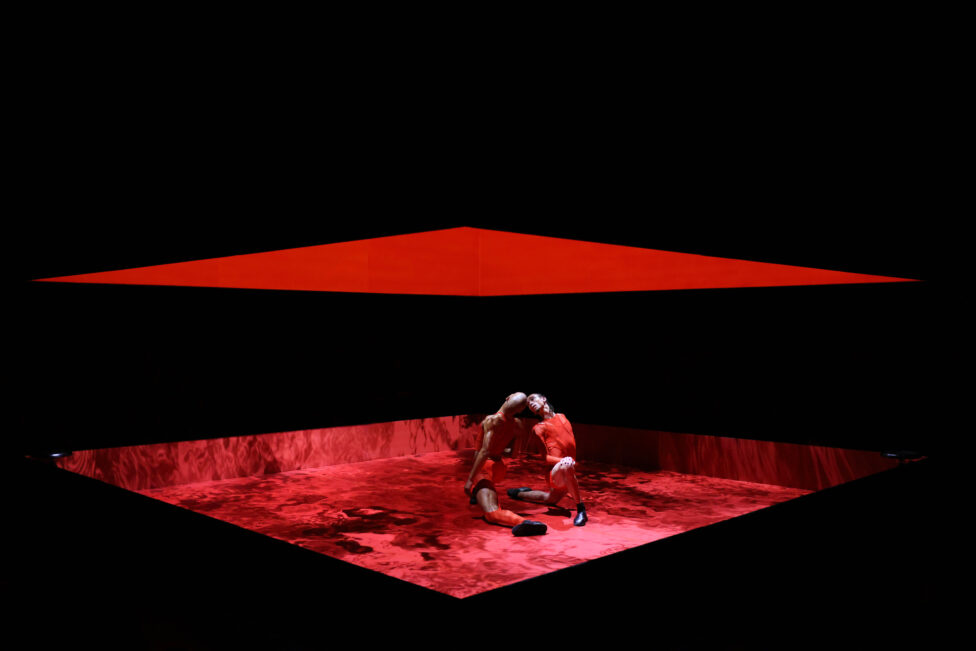
Photo by Jeremy Lawson, courtesy of MCA Chicago
SP: That’s so good to hear. Because I think your journey through Touch of Red (especially all of the performances we had this year) was so meaningful and profound. How electric you became in your body and in your presence, and also how much you surrendered into the moment and shared that experience with us. I think I was really touched by that, by your vastness and sort of bravery even with moments of fear. Because you faced that, and also with coupling, coupling is very challenging. Because you can shape yourself or the other and that sense of projection that comes from being with someone else, right, and being sort of matched with someone else and then if that projection is with hardness It can block or become blocked and create a wall, or like a bouncing away from and with Touch of Red we are trying to melt into.
TF: Right. Healing and console.
SP: What was one of the most challenging moments for you during the creative process? Well during the experience of touch of red? Because we’ve been working on it since 2020, right? Is that true?
TF: Yes, I would definitely still say the bows. The bows are still the most challenging. I would say, speaking of vulnerability too, just going through this one hour and one minute of physical intensity with somebody who you’re really close with and share a very dynamic relationship with each other. Because I see you in many ways, and I feel like you see me in many ways too you know.
SP: I see you
TF: Huh? Yes, I see you too. And after all of that, to still be yourself and even go and sit in front of the audience and then verbally express yourself and be even more vulnerable. That I think is one of the most challenging things because you just did all of that and then it is like and … one more time, and one more time, and another time, and another time.
SP: Yes, the bows in Touch of Red, what happens at the bows is that the audience are seated on all four sides and are positioned in a horizontal viewpoint to you and I and they have access to each of these sides for one hour and one second. At the end of the piece, we take out stools and we go sit in front of each of the four sides of the audience, one side at a time, and we have a conversation that is shared to each side…Those are the bows.”
I think, really one of the first inspirations for the bows was sort of investigating why we bow? What is the actual ritual about? And is it empty now? Is it based in aristocracy, caste systems, white supremacy? Is it about the sort of courtships and historical positioning of people in power and people who entertained those people in power? And this dynamic of superiority or inferiority and sort of bowing in front of kings as they clap with approval from above us, like what are we doing? Are we entertaining eurocentrism, colonialism, dominance by practicing rituals that no longer serve the intended purpose?
It’s interesting how even the set in Touch of Red provoked different questioning in terms of how we (the performers and the audience) relate to each other, especially during the bows, because if the audience are all in horizontal view to you and I (the performers) why are we vowing? It felt like we could meet them more horizontally. And also this sense of over pouring, this work is so much of a match, so much of exerting of energies in order to really melt into effeminacy in this sort of extreme bearing of yourself.
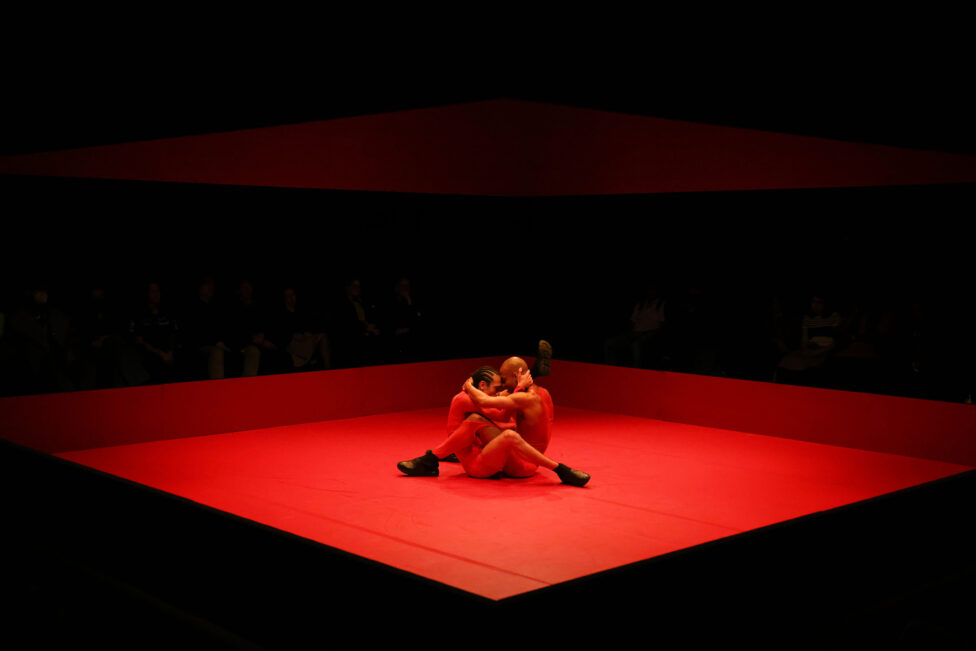
Photo by Jeremy Lawson, courtesy of MCA Chicago
TF: Fully exposed, yes!
SP: To use our voice, similar to what you were describing with the artist you are working with for Solace of RED (TRIBE’s new project), to kind of use our voice during the bows to offer the words of what’s happening through the experience and also how you can make words dance. Also that takes a lot of vulnerability from us but also from the audience too, because we are totally exposing ourselves to them, and then because of that they then felt exposed and rendered visible as well.
TF: Like you said, I felt like there is a moment in the work where it almost becomes like a mirror. I mean it is not the same experience but it is like you are offering them a moment of reflection inside of their own journey and their own experience. I mean, I think it is brilliant in a way of if I were to be the audience who would be sitting there and having to listen and then having to reflect on my own journey, I feel like especially for black men and men of color, to be in the audience and just sitting across from us, it really becomes a mirror. And the question is are you really able to connect? Because before it was a visceral connection and physical but then something about sharing the words and the gaze with each other feels like it directly draws you in. It makes you think, damn is he talking about me? Or is he talking about my experience?
SP: Because we are not telling them what to think, we are promoting thought. We are not telling them what to feel, we are provoking feeling. And there is this open door to the possibility to consider further thoughts and feelings. With the shedding and the nakedness of our words and offering them to the audience during the vows.
TF: What would you say was one of the most challenging experiences for you in the process of Touch of Red?
SP: There have been so many challenges, although I would say that it was literally the best flowing creation process I’ve ever had. Actually with you I had a great source of inspiration, I felt we came into the studio and things happened. There was energy, there was movement, there was inspiration, there was spirit, there was physicality but I think really one of the challenges for me at the beginning (well maybe for two years) was endurance. How can I continue in terms of the intense physical demand of this work that’s also non stop and requires letting go in order to continue, I’ve never created so much movement in any other work, it was also fast and a lot of footwork and switching and being with you, and being with you … and … being with you.
I felt like, how can I also be with myself so that I don’t die from this thing that’s non stop? Which is actually good, because it was really scary at first, because you are 10 years younger than I am but, either way I think regardless of that, the work is non stop movement. So I had a lot of moments of fear essentially in saying how do I sustain this physicality that’s being asked of me in each round without stopping? But in the same way investigating those fears led to discoveries of the work and offered the opportunity to take a ‘break’ onstage and say ‘this is enough for now, lets go to our separate corners, sit in our stool, wipe off all that sweat, blow our nose, drink water, find rest and restore. So much of the black experience is that we need so much resistance and resilience and I was like rest, rest and restoration. And I’m happy we found that moment where we also allowed us in a very genuine way, a necessary way, to take a break while being on stage, with the audience during a performance.
A lot of people said that, that was the moment that they felt really exhausted and also sad and also with gratitude. I heard similar things too about Territory of the Heart, you know, your solo. That I was fortunate enough to see twice, they were like, how can one person be so compelling that they kind of grab us into the experience? absorbs us into the experience and then that absorption, they never wanted it to end.
TF: Yes, well that’s good for them, not wanting to end, but I definitely wanted it to,
SP: It was time, it was time to end.
TF: I also want to bring about that with the dancers that I’m going to work with in Solace of RED, Because what you shared now, being so fully inside of the experience with dancing inside of a work, performing inside of a work, I feel like that is such a key thing, because like you always say, is bigger than you, is bigger than yourself and when you are able to fully immerse yourself inside of that experience it allows for the bubble to open up and go far out. And that is something I learned from Territory, and I’m excited now to work with four dancers for Solace of Red because I feel like it was personally for me a portal for learning that and experiencing that. And now I really want to share and cultivate that with the other four dancers. That is something that I’m really, really looking forward to. Because everytime I see you dance that’s one of the many things that I admire about you, I also admire that you give yourself fully to the experience of it and your like “well I feel this about this, and then fell this about that and this is what it is” and that allows me as a viewer (when I see you perform) like I can go on the journey with you and all the many layers there are in it.
SP: Yes, it’s like Toni Morrison has this quote that says “If we serve we last”. Being in the purpose of something larger than you, which is also what we’ve been saying from the beginning, understanding that it’s a part of you as well. Immerse yourself into something, it’s the best feeling to really allow yourself to fall into a work. So good, so good. Because then it allows space for the multiplicity of being in this life and what it means to be whole, like we were talking about; what it means to be.
TF: To come out, yes!
SP: Did we want to share anything else? Having any questions or things we want to talk about? Or are we good?
TF: No, well, I’ll share that I’m really really grateful for Touch of RED and just you and TRIBE and it was also the work, like you said, the work is a lesson. And I feel like I also learned a lesson, many lessons. And hopefully we get to do it again.
SP: Yes, we will. Thanks for being such a good partner. And also for being brave and going for the ride. I cannot imagine creating this work with anyone else who has so much trust and candor, vulnerability and virtuosity and that would allow us to kind of be sensing each other, our own limits and each other’s limits, and even going beyond them. And also, just the small nuances of a state of being that is so naked. You are a really really great collaborative partner. You are the best.
TF: Well, you are the best.

